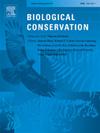Increased wind flood frequency leads to decreased nest success of endangered waders in managed shore meadows
IF 4.9
1区 环境科学与生态学
Q1 BIODIVERSITY CONSERVATION
引用次数: 0
Abstract
Climate change is expected to raise sea-levels and increase sea-level variation, which can have negative effects on the biodiversity of low-lying coastal areas. Using long-term mareograph (1970–2023) and breeding data (2002−22), we studied the occurrence of wind floods and their influence on breeding success in two endangered wading birds, the southern dunlin (Calidris alpina schinzii) and the ruff (Calidris pugnax) in managed coastal meadows in the northern Baltic Sea. In both species, flooding was an important cause of nest losses (dunlins 23.9 %, ruffs 21.4 %). Nest losses due to flooding increased from 10 % to 46 % during the 20-year dunlin study period, and from 9 % to 49 % during the seven-year ruff study period. Dunlins, but not ruffs, breed now closer to the shoreline than in the beginning of the study period. This can likely be explained by long-term overgrowth and increase in sward height in upper meadows due to lacking or inappropriate management. After a water level rise of 40 cm or more, flood losses in dunlins increased sharply, while in ruffs only moderately. Importantly, the frequency of floods reaching such critical levels has increased during the last 50 years. These flooding events require strong winds, but not actual storm winds. The increased flooding risk should be considered when planning the management of meadow habitats. Narrow elongated areas along shorelines should be avoided. Instead, management should secure attractive short growth habitats in the upper parts of meadows that are safe from flooding.

求助全文
约1分钟内获得全文
求助全文
来源期刊

Biological Conservation
环境科学-环境科学
CiteScore
10.20
自引率
3.40%
发文量
295
审稿时长
61 days
期刊介绍:
Biological Conservation is an international leading journal in the discipline of conservation biology. The journal publishes articles spanning a diverse range of fields that contribute to the biological, sociological, and economic dimensions of conservation and natural resource management. The primary aim of Biological Conservation is the publication of high-quality papers that advance the science and practice of conservation, or which demonstrate the application of conservation principles for natural resource management and policy. Therefore it will be of interest to a broad international readership.
 求助内容:
求助内容: 应助结果提醒方式:
应助结果提醒方式:


